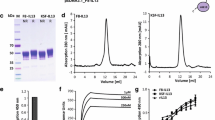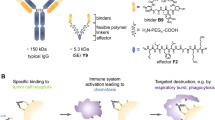Abstract
Targeting drugs to tumor cells is a central challenge for improving existing cancer therapies. ACDCRGDCFCG peptide (RGD-4C) binds to αvβ3 integrin, which is selectively expressed in tumor blood vessels and on the surface of some tumor cells. Interleukin 24 (IL-24) is a novel cancer growth-suppressing and apoptosis-inducing cytokine. To enhance the antitumor effect, we coupled RGD-4C to the N-terminus of IL-24 and expressed RGD-IL-24 in Escherichia coli. Cell proliferation and adhesion experiments revealed that RGD-IL-24 specifically binds to MCF-7 cancer cells, and induces apoptosis of MCF-7 cancer cells. These studies support the use of the RGD-IL-24 protein in tumor-targeting therapy.





Similar content being viewed by others
References
Caudell, E. G., Mumm, J. B., Poindexter, N., Ekmekcioglu, S., Mhashilkar, A. M., Yang, X. H., et al. (2002). The protein product of the tumor suppressor gene, melanoma differentiation-associated gene 7, exhibits immunostimulatory activity and is designated IL-24. Journal of Immunology, 168, 6041–6046.
Fisher, P. B., Gopalkrishnan, R. V., Chada, S., Ramesh, R., Grimm, E. A., Rosenfeld, M. R., et al. (2003). mda-7/IL-24, a novel cancer selective apoptosis inducing cytokine gene: from the laboratory into the clinic. Cancer Biology & Therapy, 2, S23–S37.
Inoue, S., Shanker, M., Miyahara, R., Gopalan, B., Patel, S., Oida, Y., et al. (2006). MDA-7/IL-24-based cancer gene therapy: translation from the laboratory to the clinic. Current Gene Therapy, 6, 73–91.
Sauane, M., Gopalkrishnan, R. V., Choo, H. T., Gupta, P., Lebedeva, I. V., Yacoub, A., et al. (2004). Mechanistic aspects of mda-7/IL-24 cancer cell selectivity analysed via a bacterial fusion protein. Oncogene, 23, 7679–7690.
Yacoub, A., Mitchell, C., Brannon, J., Rosenberg, E., Qiao, L., McKinstry, R., et al. (2003). MDA-7 (interleukin-24) inhibits the proliferation of renal carcinoma cells and interacts with free radicals to promote cell death and loss of reproductive capacity. Molecular Cancer Therapeutics, 2, 623–632.
Su, Z., Lebedeva, I. V., Gopalkrishnan, R. V., Goldstein, N. I., Stein, C. A., Reed, J. C., et al. (2001). A combinatorial approach for selectively inducing programmed cell death in human pancreatic cancer cells. Proceedings of the National Academy of Sciences of the United States of America, 98, 10332–10337.
Ruoslahti, E. (2003). The RGD story: a personal account. Matrix Biology, 22, 459–465.
Assa-Munt, N., Jia, X., Laakkonen, P., & Ruoslahti, E. (2001). Solution structures and integrin binding activities of an RGD peptide with two isomers. Biochemistry, 40, 2373–2378.
Curnis, F., Gasparri, A., Sacchi, A., Longhi, R., & Corti, A. (2004). Coupling tumor necrosis factor-alpha with alphaV integrin ligands improves its antineoplastic activity. Cancer Research, 64, 565–571.
Dickerson, E. B., Akhtar, N., Steinberg, H., Wang, Z. Y., Lindstrom, M. J., Padilla, M. L., et al. (2004). Enhancement of the antiangiogenic activity of interleukin-12 by peptide targeted delivery of the cytokine to alphavbeta3 integrin. Molecular Cancer Research, 2, 663–673.
Lowry, O. H., Rosebrough, N. J., Farr, A. L., & Randall, R. J. (1951). Protein measurement with the folin phenol reagent. Journal of Biological Chemistry, 193, 265–275.
Yang, J., Zhang, W., Liu, K., Jing, S., Guo, G., Luo, P., et al. (2007). Expression, purification, and characterization of recombinant human interleukin 24 in Escherichia coli. Protein Expression and Purification, 53, 339–345.
Ramesh, R., Mhashilkar, A. M., Tanaka, F., Saito, Y., Branch, C. D., Sieger, K., et al. (2003). Melanoma differentiation-associated gene 7/interleukin (IL)-24 is a novel ligand that regulates angiogenesis via the IL-22 receptor. Cancer Research, 63, 5105–5113.
Sauane, M., Lebedeva, I. V., Su, Z. Z., Choo, H. T., Randolph, A., Valerie, K., et al. (2004). Melanoma differentiation associated gene-7/interleukin-24 promotes tumor cell-specific apoptosis through both secretory and nonsecretory pathways. Cancer Research, 64, 2988–2993.
Gupta, P., Su, Z. Z., Lebedeva, I. V., Sarkar, D., Sauane, M., Emdad, L., et al. (2006). mda-7/IL-24: multifunctional cancer-specific apoptosis-inducing cytokine. Pharmacology and Therapeutics, 111, 596–628.
Su, Z. Z., Madireddi, M. T., Lin, J. J., Young, C. S., Kitada, S., Reed, J. C., et al. (1998). Fisher PB: The cancer growth suppressor gene mda-7 selectively induces apoptosis in human breast cancer cells and inhibits tumor growth in nude mice. Proceedings of the National Academy of Sciences of the United States of America, 95, 14400–14405.
Xiong, J. P., Stehle, T., Zhang, R., Joachimiak, A., Frech, M., Goodman, S. L., et al. (2002). Crystal structure of the extracellular segment of integrin alpha Vbeta3 in complex with an Arg-Gly-Asp ligand. Science, 296, 151–155.
Janssen, M. L., Oyen, W. J., Dijkgraaf, I., Massuger, L. F., Frielink, C., Edwards, D. S., et al. (2002). Tumor targeting with radiolabeled alpha(v) beta(3) integrin binding peptides in a nude mouse model. Cancer Research, 62, 6146–6151.
Mizuguchi, H., Koizumi, N., Hosono, T., Utoguchi, N., Watanabe, Y., Kay, M. A., et al. (2001). A simplified system for constructing recombinant adenoviral vectors containing heterologous peptides in the HI loop of their fiber knob. Gene Therapy, 8, 730–735.
Arap, W., Pasqualini, R., & Ruoslahti, E. (1998). Cancer treatment by targeted drug delivery to tumor vasculature in a mouse model. Science, 279, 377–380.
Acknowledgments
We would like to thank Dr. Youjun Feng, a visiting scholar in Faculty of Medical Laboratory Science, Third Military Medical University (Present address: Department of Microbiology, University of Illinois at Urbana-Champaign (UIUC), USA) for critical reading of this manuscript. We are grateful to Prof. Wei-Ke Si and Dr. Hong Guo for their constructive suggestion and for kindly providing NHLF cell line.
Author information
Authors and Affiliations
Corresponding author
Rights and permissions
About this article
Cite this article
Xiao, B., Li, W., Yang, J. et al. RGD-IL-24, A Novel Tumor-Targeted Fusion Cytokine: Expression, Purification and Functional Evaluation. Mol Biotechnol 41, 138–144 (2009). https://doi.org/10.1007/s12033-008-9115-y
Received:
Accepted:
Published:
Issue Date:
DOI: https://doi.org/10.1007/s12033-008-9115-y




